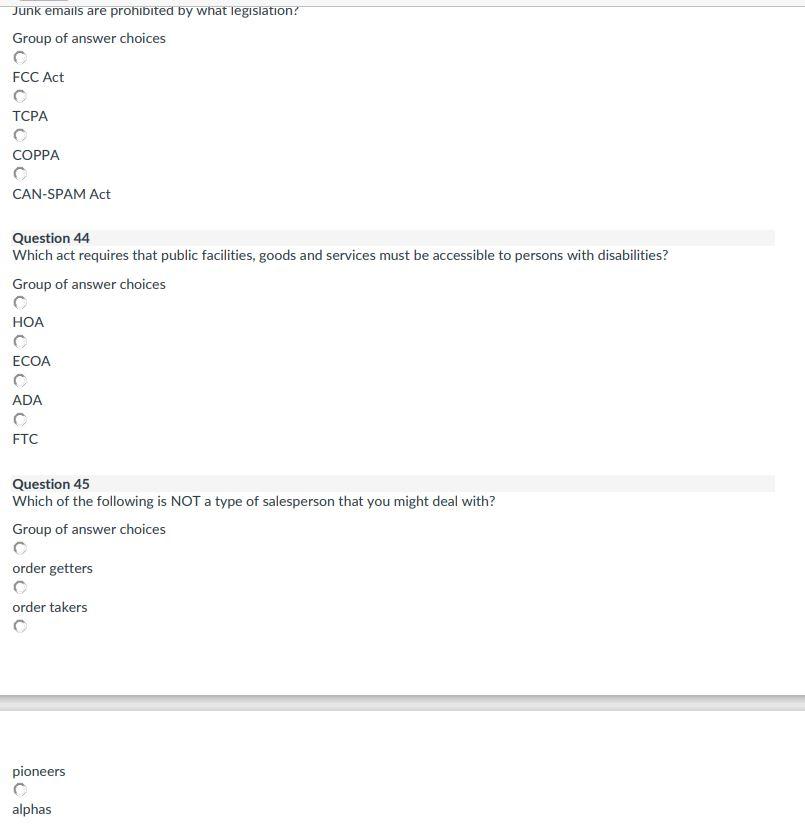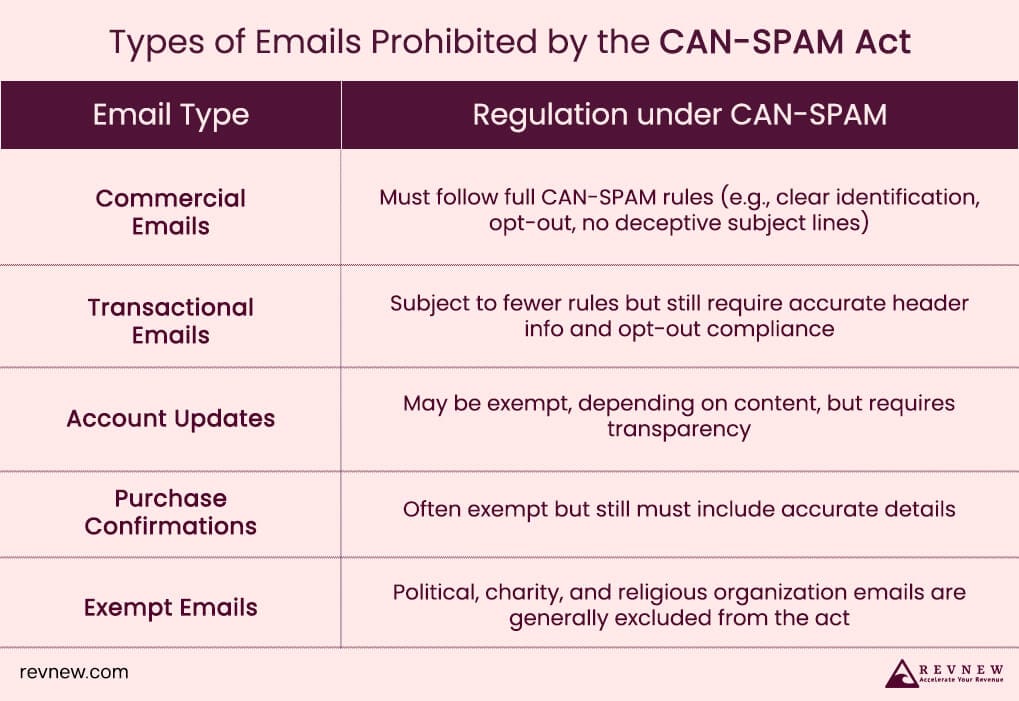The CAN-SPAM Act sets rules for commercial emails. It aims to protect consumers from spam.
Understanding which emails are prohibited by the CAN-SPAM Act is crucial for businesses. Violating these rules can lead to hefty fines and damage your reputation. This federal law outlines specific types of emails that are not allowed. From misleading subject lines to failing to provide a clear way to opt-out, the CAN-SPAM Act covers it all.
Knowing these rules helps ensure your email marketing stays compliant. We’ll explore the kinds of emails you must avoid. Stay informed to keep your email practices lawful and respectful.

Credit: chamaileon.io
Introduction To The Can-spam Act
The Can-Spam Act is a law that sets rules for email. It gives recipients the right to stop receiving emails. It also sets penalties for those who break the rules. The Act aims to protect consumers from unwanted and misleading emails.
This law was signed in 2003. It applies to all commercial messages. These are emails that promote or advertise products or services. The goal is to make email communication more transparent and fair.
Purpose Of The Act
The main goal of the Can-Spam Act is to reduce spam. Spam is any unwanted email that clutters inboxes. The Act helps to make sure emails are sent only to those who want them. It also stops companies from sending false or misleading information.
Another purpose is to protect privacy. The Act requires that businesses provide a way for recipients to opt out. This means they can choose not to receive further emails. This gives control back to the recipient.
Importance For Businesses
Businesses must follow the Can-Spam Act to avoid penalties. Breaking the rules can lead to heavy fines. It is important for businesses to understand and comply with the Act.
Following the Act also helps build trust with customers. When businesses respect email rules, customers feel more secure. This can lead to better customer relationships and loyalty.
Complying with the Act can improve email marketing efforts. It ensures that emails reach interested recipients. This can result in higher engagement and better conversion rates.
Commercial Vs. Transactional Emails
Understanding the difference between commercial and transactional emails is crucial for compliance with the CAN-SPAM Act. Knowing which types of emails are prohibited can save businesses from legal issues. Let’s break down what each type of email entails.
Defining Commercial Emails
Commercial emails aim to promote or advertise a product, service, or brand. They often include newsletters, promotional offers, and sales announcements. These emails require clear identification as advertisements. They must include a valid physical address and an easy way to opt out.
Defining Transactional Emails
Transactional emails provide information related to an ongoing transaction. Examples include order confirmations, shipping updates, and account notifications. These emails are essential for customer service. They do not require the same compliance measures as commercial emails. Transactional emails must not contain promotional content.
Prohibited Practices In Commercial Emails
The CAN-SPAM Act outlines strict rules for commercial emails. It aims to protect consumers from unwanted messages. Violating these rules can result in hefty fines. Understanding prohibited practices helps ensure compliance. Let’s explore key areas where businesses often go wrong.
Misleading Subject Lines
Subject lines must accurately reflect the email’s content. Deceptive subject lines mislead recipients. Avoid sensational or exaggerated claims. For example, “You’ve Won $1,000,000!” if the email is only about a discount offer. Misleading subject lines can harm your credibility. Always be honest in your email subject lines.
False Or Deceptive Headers
Headers include the “From,” “To,” and “Reply-To” fields. These must clearly identify the sender. Using false names or domains is prohibited. For example, don’t use a celebrity name if they are not involved. The sender’s information must be accurate. This ensures transparency and builds trust. False headers can lead to penalties.

Credit: www.chegg.com
Requirements For Legal Compliance
The CAN-SPAM Act sets the rules for commercial emails. It gives recipients the right to stop receiving them. Strict penalties apply for violations. Understanding these requirements helps businesses stay compliant.
Accurate Sender Information
The sender’s information must be clear and accurate. This includes the “From,” “To,” and “Reply-To” fields. Do not use false or misleading header information.
| Field | Requirement |
|---|---|
| From | Must accurately reflect the sender’s identity |
| To | Must be the intended recipient’s email address |
| Reply-To | Must provide a valid email address for responses |
Clear Identification As An Ad
Emails must clearly state they are advertisements. The message should be honest and clear. This transparency builds trust with recipients.
- Include a statement like “This is an advertisement.”
- Do not hide this statement in small print.
- Ensure accurate sender information.
- Clearly identify the email as an ad.
Opt-out Mechanism
The CAN-SPAM Act ensures that businesses follow specific rules when sending emails. One critical aspect is the opt-out mechanism. This allows recipients to unsubscribe from future emails. Understanding the opt-out mechanism helps businesses stay compliant. It also respects the recipient’s preferences.
Providing An Easy Opt-out
Businesses must offer a clear and straightforward way to opt out. The process should be simple for the recipient to follow. Include an unsubscribe link in each email. Ensure the link is easy to find. It should not be hidden in the fine print.
Best practices include:
- Using clear language like “Unsubscribe” or “Opt Out”
- Placing the link at the bottom of the email
- Ensuring the link works and leads to a functional page
Honoring Opt-out Requests
Once someone opts out, their request must be honored promptly. The CAN-SPAM Act requires businesses to process opt-out requests within 10 business days. Ignoring these requests can lead to penalties.
Steps to ensure compliance:
- Monitor the opt-out link regularly
- Update email lists to remove opt-outs
- Confirm that the recipient’s email is no longer active in your list
Respecting opt-out requests builds trust with your audience. It also helps maintain a positive reputation.
Consequences Of Non-compliance
Understanding the consequences of non-compliance with the CAN-SPAM Act is vital. Violating this law can lead to severe repercussions. These include hefty penalties and potential legal actions. Businesses must comply to avoid these risks.
Penalties And Fines
Non-compliance with the CAN-SPAM Act can result in significant fines. Each email in violation can incur penalties of up to $43,280. This amount can add up quickly, creating a substantial financial burden. Even small businesses can face these hefty fines.
Legal Actions
Violating the CAN-SPAM Act can also lead to legal actions. The Federal Trade Commission (FTC) can pursue lawsuits against violators. Legal actions can result in court orders, forcing compliance. This can damage a company’s reputation and cause long-term harm.
Best Practices For Email Marketing
Email marketing is a powerful tool for businesses. However, it’s important to follow best practices to comply with the CAN-SPAM Act. This law sets rules for commercial emails. It gives recipients the right to stop receiving emails from you. It also outlines penalties for violations. Following these best practices can help you stay compliant and build trust with your audience.
Crafting Compliant Emails
Always use honest subject lines. They should reflect the content of the email. Misleading subject lines are prohibited by the CAN-SPAM Act. Clearly identify the email as an advertisement. This helps avoid confusion for the recipient.
Include your physical address. This can be your current street address, a post office box, or a private mailbox. It’s a way to verify that you are a real business. Provide a clear way to opt-out of future emails. The opt-out mechanism must be easy to find and understand. Honor opt-out requests promptly, within 10 business days.
Maintaining Email Lists
Keep your email lists clean and up-to-date. Remove invalid email addresses. This reduces bounce rates and improves deliverability. Regularly check for duplicate entries. This ensures your messages reach the intended audience.
Segment your email lists. This means categorizing your subscribers based on their interests. It helps you send more relevant content. Avoid purchasing email lists. Sending emails to people who did not sign up can lead to complaints. Use double opt-in methods. This ensures that subscribers really want to receive your emails.

Credit: www.mayple.com
Resources And Tools
Understanding the types of emails prohibited by the CAN-SPAM Act is crucial for staying compliant. But how do you ensure that your emails follow the law? There are many resources and tools available to help you. These tools can guide you and ensure your emails are compliant.
Government Guidelines
The Federal Trade Commission (FTC) provides clear guidelines on the CAN-SPAM Act. They detail what businesses can and cannot do. These guidelines are free and available online. They help you understand the basics of email compliance.
By following these guidelines, you can avoid common mistakes. The FTC website also offers tips for creating compliant emails. This makes it easier for you to stay within the law.
Email Compliance Software
Email compliance software helps ensure your emails meet legal standards. These tools check your emails for compliance issues. They alert you to potential problems before you send the email.
Some popular email compliance tools include Mailchimp, Constant Contact, and Sendinblue. These tools offer features to help you follow the CAN-SPAM Act. They also provide templates and checklists to keep your emails compliant.
Using email compliance software can save you time and reduce the risk of penalties. It ensures that all your emails are in line with the law. This helps protect your business and your reputation.
Frequently Asked Questions
What Are Prohibited Email Practices Under The Can-spam Act?
The CAN-SPAM Act prohibits misleading subject lines, false information, and harvesting email addresses. It also bans using deceptive headers.
Can I Use False Headers In Marketing Emails?
No, the CAN-SPAM Act strictly prohibits the use of false or misleading headers in any commercial emails.
Are Misleading Subject Lines Allowed?
No, misleading subject lines are prohibited under the CAN-SPAM Act. Subject lines must accurately reflect email content.
What Is Email Harvesting?
Email harvesting is collecting email addresses without consent. The CAN-SPAM Act strictly prohibits this practice.
Conclusion
Understanding the Can-Spam Act is crucial for email marketing. Avoiding prohibited emails helps maintain trust and legal compliance. Always get permission before sending emails. Ensure your content is relevant and respectful. Misleading subject lines and fake headers are big no-nos.
Clear opt-out options are a must. Stay informed about the law to protect your reputation. Following these rules ensures your emails are welcomed, not marked as spam. Keep your audience happy and engaged.
